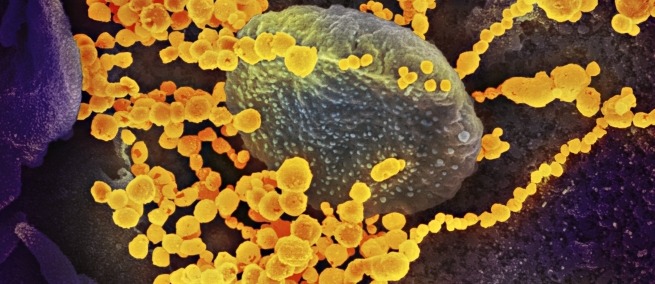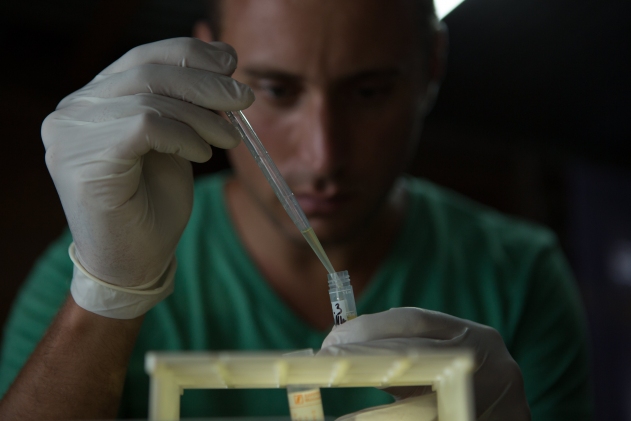
National Geographic’s new one-hour special VIRUS HUNTERS reveals how scientists around the world—focusing mostly on Liberia and the U.S.—study the social, environmental, and biological factors that contribute to pandemics such as COVID-19. Their aim is to be better prepared for the next one. VIRUS HUNTERS premieres on National Geographic on November 1. We spoke with epidemiologist and ecologist Christopher Golden, a professor at Harvard’s School of Public Health who is featured in the special, about the issues raised.
Science & Film: Why did you agree to be part of VIRUS HUNTERS?
Christopher Golden: For more than 20 years I’ve been working in Madagascar and living in communities that rely on wildlife for food, so I’ve always been aware of the potential risks of wildlife consumption, but had never truly been aware of all of the benefits—in these remote communities where you have greater than 50% malnutrition and more than 80% prevalence of severe poverty, people rely on these types of natural resources for their livelihoods, their wellbeing, and their health. It’s this conflict between being able to provide food for your family and also preventing the next pandemic that a perfect storm of activities is brewing. So, when Nat Geo approached me about doing a special on this, my first reaction was, I’m not an expert in the infectious disease aspects. But they wanted someone with more of a 50,000-foot view of the underlying conditions and contexts that precipitate disease emergence events. What got me excited was sharing my knowledge of planetary health and the ways in which environmental change is leading to human health impacts. [VIRUS HUNTERS], in the context of COVID and everything that’s happening around the world paralyzing societies, could be used to talk about this really important and inextricable connection between people and planet.

Christopher Golden in VIRUS HUNTERS. Courtesy of National Geographic.
S&F: Right, this is obviously a global story.
CG: My research is based on Madagascar in the South Pacific, but I live in Boston so I’m very aware of the issues happening domestically. The types of disease emergence that we look at don’t need to happen in distant locations. These are things that can happen anywhere where we are transforming the environment and causing people to come in closer and closer contact with wildlife and domesticated animals.
Going to industrial farming sites [in the U.S.] and understanding the degree to which we are creating a recipe for viral spillover is really interesting; we are housing animals in very close quarters at high density. The entire process is undoubtedly stressful, stress causes animals to have reduced immune systems, which will cause a process called “viral shedding” whereby viruses have rapidly increasing rates of production and that can lead to spillover. This does not need to be an exotic animal species; this could be happening in someone’s backyard.
S&F: You’re pointing out how the wellbeing of animals has a big effect on transmission. Is that right?
CG: That’s absolutely right. If you think about sea temperatures rising, coral bleaching, deforestation, mining, agricultural expansion, these changes are reshaping the surface of the earth. The destruction of animals' homes is going to lead to animals becoming more and more stressed and then becoming a greater risk for spillover. Human population growth and these environmental changes are bringing humans into closer contact with both wildlife and domesticated animals, and that is the recipe for disease emergence.
S&F: Bats in particular seem to be unique vectors for viruses, can you explain why?
CG: The total number of mammal species in the world is around six or seven thousand. One fourth of those are bats so from a statistical standpoint they are a likely source for diseases that are transmitted from mammals to humans. There is also an evolutionary and physiological rationale: bats are the only mammals to have evolved flight, and with that evolution they have evolved unique immune systems that are resistant to many viruses. It allows for reproduction and propagation of these viruses within their populations.
S&F: So is there always a next pandemic?
CG: The best way to predict the future is to look back, and we have seen that disease transmission from wildlife to humans has caused devastating effects historically. HIV/AIDS, SARS, MERS, Ebola, Swine Flu, the 1918 flu, all of these were caused from a transmission event from animals to humans that had cascading effects across the world. COVID-19 has the characteristic of being very transmissible. If you pair something with high transmissibility with the case fatality of these other diseases that we’ve witnessed, it could be even worse than what we’re seeing with COVID. We know that these events have occurred frequently in our past and are bound to happen in our future.
S&F: In terms of mitigating a virus’s spread, how much of that do you see as research into the biological mechanisms of disease transmission and how much do you see as changing human behavior?
CG: I think we need to tackle this from all angles. We have all of the drivers—environmental, social, or cultural—that are leading to increasing contact between humans and wildlife. So, we need to reduce rates of deforestation, forest fires, and mining has to have greater regulations to minimize these exposure events. Also, VIRUS HUNTERS does a really great job of understanding the work that the frontline researchers are doing chronicling viruses, pathogens, and bacteria that are present within wildlife populations so that they can then characterize ones that might be more predisposed to crossing the species barrier. You can pass that knowledge on to organizations like the CDC to preemptively prepare vaccines for a novel virus. Then you need to have systems in place where we can actually respond to pandemics once they occur. I think that was the piece that we were least prepared for when COVID-19 happened. What was shocking to me was how ill-prepared we were as a society to respond in an effective and efficient way.
S&F: What do you predict as the next year for COVID-19?
CG: I am hopeful that over time a vaccine will be developed. I am less confident about some of the timelines that are being proposed because I know what incredible research and enormous amounts of safety and monitoring have to go into those protocols and approvals. I am thinking that we are more likely to establish a “new normal” of being cautious about our hygiene and sanitation than we are to have some rapid technological fix that repairs everything without changing our behavior.
♦
VIRUS HUNTERS is produced by Lincoln Square Productions for National Geographic. It airs globally on National Geographic on November 1 at 9pm ET, and is an accompaniment to the November issue of National Geographic Magazine that focuses on COVID-19. In addition to Christopher Golden, the special features ABC News correspondent James Longman, Virus Gene Tracker Supaporn Wacharaplusadee, and DARPA researcher Rohit Chitale.
TOPICS